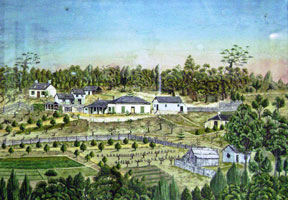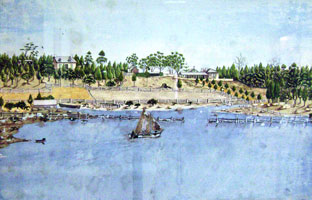Sydney Procure
The Marists established in Sydney a supply-base for their Pacific mission. An account of the purchase of the first property can be found in doc. 636.
 |
After a search of nearly four decades two historical Marist paintings have been returned to Sydney.
The paintings depict the earliest Marist buildings near Tarban Creek, Hunters Hill, which served as a base for the newly-established missions of the Society of Mary in the south-west Pacific. They were housed variously in Rome and at La Neyliere, France, where they were discovered in a basement after going missing in the 1970's. |

|
Fr Michael Mullins SM recently returned from Rome bringing with him the paintings dating from 1854 and commissioned by the then-procurator of the Marist Missions of the Pacific, Fr Rocher. 'It's the end of a thirty-five year saga', says Fr Michael who has been searching for the lost paintings since 1974.
|
Peter McMurrich's historical notes
MARIST FATHERS’ VILLA MARIA PROPERTY: BRIEF HISTORY
The First “Villa Maria” The Marist Fathers arrived in Sydney in 1845, and first came to Hunters Hill in 1847, but not to the present Villa Maria site. The original Villa Maria was a grouping of buildings on the other side of Tarban Creek, now known as “The Priory”.
In 1863, work began on building the present Villa Maria monastery. The Marists had decided to abandon their earlier site because of the poor quality of the soil for growing purposes, the desire for a better water access for transport, and the encroachment of the Gladesville Hospital.
While some parts of the new building were in use much earlier, the major relocation of the community to the new site appears to have occurred just prior to Christmas, 1865: “In three weeks, that is, around Christmas, we shall move to our new house” [Circular from Poupinel to Sisters in Oceania, 6/12/65 in Our Pioneer Sisters].
The purpose of the Marist establishment at Hunters Hill during the 19th century was to operate as a supply base for Marist mission ventures in Central Oceania; to be a sanatorium for sick missionaries coming to Sydney from the Pacific Islands for treatment; to be a transit base for missionaries travelling from Europe via Sydney to the Islands; and to provide renewal programmes called “second novitiates” for missionaries who had been in the Islands for 10 years or more. The priests at the monastery also cared for the parish of Hunters Hill, and provided chaplaincies to St Joseph’s College, and the Gladesville Hospital.
NOTES ON BUILDINGS (Refer Map).
1. Southern wing. Part of the original construction (1863-65). The ground floor was at one time the monastery kitchen; upstairs was divided into cubicles for accommodation for the coadjutor brothers.
Western Wing. Completed in 1929, 65 years after the original monastery construction, hence the use of cement render rather than sandstone. However, for the sake of appearances, a sandstone facing was used on the “public” side of this wing. Stone for the facing came from the demolition of a building called the “gatehouse”, situated nearby, and from a small stone building which the Western Wing replaced.
2. "Woodbury Hall". Constructed 1902-3. Ground floor became the new kitchen for the monastery, and dining room for the Third Order of Mary Regular Sisters. Upstairs was overflow accommodation for the use of Third Order of Mary Regular Sisters visiting Sydney. After 1929, with the building of the Western Wing which accommodated a modern kitchen, the entire building became available for use by the Sisters.
"Piquet Centre". In 1874 a “small house” was built on the property as accommodation for Sr M. De La Merci, (a Marist Tertiary), Sara & Silenia ( Futunan aspirants to the sisterhood) and for kitchen maids. This was a direct result of the sale of “The Priory” buildings to Thomas Salter in June 1874, for these latter had been used since 1865 as a convent for Third Order of Mary/ Our Lady of the Missions Sisters. There is a very high probability that the Piquet Centre is the “small house” built in 1874 for the Sisters. Alternatively, in 1870 a school and teachers’ residence was built somewhere on the property as the second site for the Villa Maria parish school. However, the Piquet Centre seems too small and too close to the existing monastery buildings to have been the 1870 school construction.
The Piquet Centre was definitely in use as the Third Order of Mary Sisters’ convent in the last decades of the 19th century and remained so until the after Second World War; it seems likely that it was specifically built for this purpose, and for accommodating domestics, in 1874.
In the 1950s and 1960s the building functioned as offices for the Procurator of the Missions.
3. Colin Library and Chanel House Both built in 1974-5, when the Marist Fathers’ Seminary was transferred from Toongabbie to Hunters Hill.
4. Memorial Stone. Placed in 1967 to commemorate the centenary of the laying of the foundation stone for Holy Name of Mary Church. The large Celtic crosses were brought from the graveyard of St Charles' Church, Ryde, where the early Marists were buried prior to 1892.
Octagonal Chapel. Built in 1863 by Fr Claude Joly sm, architect and supervisor of works for Villa Maria Monastery and Church, it was the first building constructed on the new Villa Maria property. Originally a 1 metre high bronze statue of St Joseph stood on top of the roof, and the chapel and statue could be easily seen from Tarban Bay in the 19th century.
5. Cemetery. Constructed (half present size) in 1908 by Fr Placid Huault, who shortly after its completion became the first person to be buried there; extended 1938.
Prior to the building of this cemetery, Marists from Villa Maria were buried in the graveyard of St Charles' Church, Ryde; and between 1893-1908 at the Field of Mars Cemetery, Ryde.
Cemetery contains graves of Marist Fathers, Marist coadjutor brothers, Third Order of Mary Regular sisters, and Marist Missionary sisters.
6. St Peter Chanel Chapel. The small sandstone building which is now called St Peter Chanel’s Chapel was originally in the grounds of the first Villa Maria Monastery (1847-1865), Hunters Hill, which was on the opposite side of Tarban Creek to the present Villa Maria property. The complex of buildings associated with the first Villa Maria is still standing, and is used by the Mental Health Review Tribunal.
In 1955 permission was obtained from the Health Department to dismantle this building, thought to have been a small chapel, and reconstruct it at the Marist Seminary at Toongabbie. It was assumed that the body of the martyr, St Peter Chanel, would have been kept in the building while on its way through Sydney on the journey to France (1849).
In fact, the original chapel built at the first Villa Maria was wooden. This stone structure was most probably constructed by Thomas Salter, a later owner of the site. It is designated as a latrine on an 1885 Survey Map, and may have been built by Salter for precisely this purpose.
There was a time lag of four years between the time the chapel was dismantled at Hunters Hill (1955), and its reassembling at Toongabbie (1959). At this time, some additional sandstone was obtained from a demolished church at Concord, and incorporated in the reconstructed building.
After the Marist Fathers' Seminary transferred from Toongabbie to Hunters Hill in 1975, the chapel was once again dismantled (1981), and reassembled on its present site (1982).
7. Villa Maria Monastery (1863-65) was built to face Tarban Bay, which was the transport link to the city in the 19th century. There was a ferry wharf on or near the site of the present St Joseph's College boat sheds, and a small boat provided a linking service with the larger harbour ferries. The arched sandstone cloister dates from 1908, and replaced an earlier ironwork balcony. The present red tiles were substituted for the original slate roof in the late 1950s or early 1960s.
8. Cellars, Stables & Cottage. The monastery had its own vineyards, principally for the manufacture of altar wine. The quality of the table wine generally left a little to be desired, although the 1874 vintage appears to have been exceptional: “This year our wine has been wonderful; we have made 16 barrels of wine, and good stuff too”. The last recorded vintage was 1906.
The cottage dates from 1877, and was constructed by a former miner by the name of Shortil, who obtained permission to construct a retirement cottage in the grounds. Mysteriously, he left the area just as the building was nearing completion.
Inspection of the stonework where the cottage intersects with the winery building suggests that the winery building postdates the cottage. The stables, on the other hand, probably pre-date the cottage (Joly 15/3/1877: “[The cottage] will be of two rooms and a kitchen, and will be built close to the stable”). The present stable may even date from 1864. (Joly, April 1864: “The building which later may be used as a stable for horses and as a barn, is finished and ready for use”).
9. Holy Name of Mary Church. Commenced in 1867 and completed in 1871. Originally only two-thirds its present length, and built as the monastery chapel. (See pamphlet).
The annex, running at right angles to the Church, dates from 1883, and was built as a school-room and to provide overflow accommodation for the church congregation on Sundays.
Compiled by Peter McMurrich sm
22/5/96 - 14/5/99